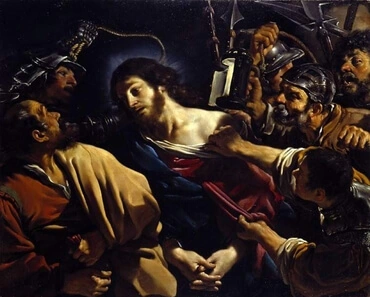Erläuterung zu Johannes 1:9
Од страна на Brian David (машина преведена во Deutsch)

Wenn wir das Wort "Wahrheit" hören, neigen wir dazu, an Aussagen zu denken, die eher kalt, trocken und akademisch sind. Diese Art von Wahrheit ist jedoch eine Form, die auf die spezifischste, äußerste Ebene gebracht wird; in ihrem Kern ist die Wahrheit einfach ein Ausdruck der Liebe, und je näher sie dieser Liebe ist, desto dynamischer, wärmer und kreativer ist sie.
Denken Sie zum Beispiel an ein schönes Bild, das von einer Person zu einer anderen über den Computer geschickt wird. Die erste Person sieht das Bild, ist davon berührt und möchte es weitergeben. Der Computer analysiert das Bild als Millionen winziger farbiger Punkte, die mathematisch ausgedrückt werden können, als Informationen, die weitergegeben werden können. Der Computer der zweiten Person erhält diese Informationen, fügt alle farbigen Punkte zusammen und zeigt das Bild, so dass die zweite Person ebenfalls berührt wird. In den Augen der beiden Personen ist dieses Bild eine relativ interne Wahrheit, ein ziemlich direkter Behälter für bestimmte Gefühle. Dazwischen, in winzige Informationsbits zerlegt, ist das Bild immer noch eine Wahrheit - es existiert immer noch - aber es ist in einer viel äußerlicheren Form, weiter entfernt vom emotionalen Inhalt.
Der ultimative "emotionale Inhalt" ist natürlich die Liebe des Herrn, die so vollkommen und mächtig ist, dass wir sie uns nur vorstellen können, wenn wir uns einen Spaziergang auf der Sonne vorstellen. Ihr unmittelbarer Ausdruck ist "das Licht" in diesem Vers - das, was die Schriften göttliche Wahrheit nennen. Es ist, als würde man dieses schöne Bild nehmen und es auf den millionsten Grad vervielfachen, bis es so schön ist, dass es uns von den Füßen haut und uns zwingt, unsere Augen zu schützen. Es ist der Ausdruck auf dem Gesicht des Herrn, wenn wir es ertragen könnten, ihn zu sehen; es ist wie der Klang seiner Stimme, wenn wir es ertragen könnten, sie zu hören. Dieses Bild ist die Wahrheit - es ist eine Art, innere Zustände auf der extremsten, exquisitesten Ebene zu teilen.
Wie können wir das also nutzen? Wie können wir diese Art von Wahrheit in unser Leben bringen? Die Antwort ist, dass wir "die Welt" sein und das Licht in "jedem Menschen" finden müssen. Die Welt steht für die Kirche, die in den Schriften als "wo der Herr bekannt ist und wo das Wort ist" definiert wird. Wir haben das Wort in Form der Bibel; den Herrn zu kennen, liegt an jedem von uns als Individuum. Der "Mensch" steht hier für die Wahrheit auf einer eher äußerlichen Ebene, für Ausdrücke der Liebe des Herrn, die auf Ideen heruntergebrochen sind, die auf unser Leben angewendet werden können.
Dieser Vers sagt uns also, dass wir, wenn wir die Bibel mit der Liebe des Herrn im Hinterkopf lesen, Ideen und Richtlinien finden, die uns dazu bringen, gute, liebevolle Menschen zu sein. Wir können uns mit der göttlichen Wahrheit verbinden und sie in kleinen Teilen erhalten, die wir verwenden können.
(Референци: Die Offenbarung Erklärt 196; Himmlischen Geheimnissen 9407 [13])
Arcana Coelestia #2179
2179. 'Abraham ran to the herd' means natural good. This is clear from the meaning of 'oxen' and 'young bulls' which are members of 'the herd', dealt with in the next paragraph. That beasts which were members of the herd and those which were members of the flock mean such things as reside with man becomes clear from what has been shown in Volume One, in 45, 46, 142, 143, 246, 714, 715, 719, 776, in addition to which, see what has been stated in 1823 about the beasts used in sacrifices. It may come as a surprise to everyone that the creatures mentioned in the Word, and also those offered in the sacrifices, meant goods and truths, or what amount to the same, celestial and spiritual things; but let the origin of this surprising fact be stated briefly.
[2] In the world of spirits various representatives manifest themselves. On many occasions animals too manifest themselves before the eyes of spirits, such as horses wearing varying decorative trappings, oxen, sheep, lambs, and different kinds of other animals; and sometimes animals such as have never been seen on earth but are purely representative. Such animals seen also by the prophets and mentioned in the Word had the same origin. Animals which appear in that world are representative of affections for good and truth, and also of affections for evil and falsity. Good spirits have full knowledge of what those animals mean, and also when they see them, they gather what it is that angels are discussing with one another, for when the conversation of those angels passes down into the world of spirits it sometimes manifests itself in this manner. For example, when horses appear, the spirits know that the angels are talking about matters of the understanding; when oxen and young bulls appear, that they are talking about natural goods; when sheep appear, about rational goods and about integrity; when lambs appear, about still more interior goods and about innocence; and so on.
[3] Because the members of the Most Ancient Church had communication with spirits and angels, constantly having visions and also dreams such as the prophets had, they consequently formed a concept of what any beast meant the moment they saw it. This was how representatives and meaningful signs originated. These remained in existence for a long time after those most ancient times, and at length were so venerated because of their antiquity that writers employed mere representatives. Indeed books that were not written in that style were not very highly regarded, nor if written within the Church considered to be holy. For the same and also other hidden reasons, which will in the Lord's Divine mercy be given elsewhere, the books of the Word too were written in that style.






